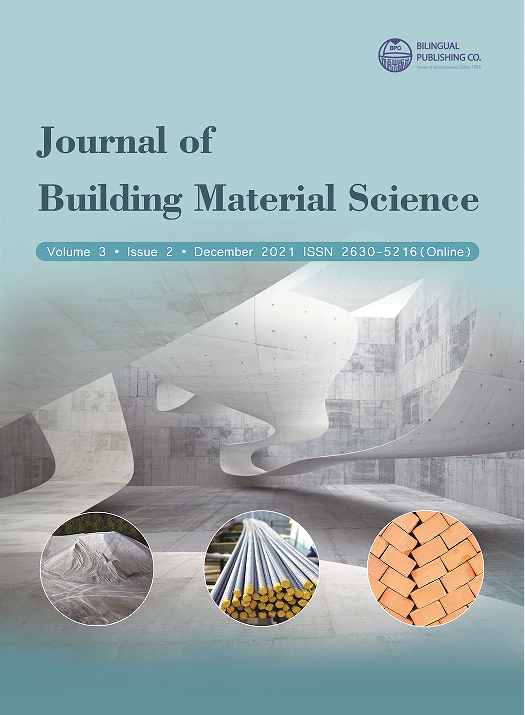
Hemp Concrete: A Sustainable Green Material for Conventional Concrete
DOI:
https://doi.org/10.30564/jbms.v3i2.3189Abstract
Concrete is one of the most important building material and day by day the utilization of concrete is increasing to meet the infrastructure development requirement. On one hand it is unavoidable but some alternative to be explored to reduce the global environmental impact caused by the concrete.To overcome this from the last decade the world is looking towards the fact of sustainability due to rapid industrialization. The growth in the construction industry increased the demand of concrete as construction material. This concrete produces significant amount of greenhouse emission in the environment. There is a need to find an alternative solution to minimize the greenhouse emission emitted from the concrete manufacturing plant. Hempcrete is a building material prepared from hemp yarns, lime and water. This composite material has several beneficial properties like low in cost, easily available, thermal and acoustic insulation, low density and sustainable cause of no adverse impact of carbon footprint on production.In this study the properties and several benefits of the hempcrete were discussed in detail.
Keywords:
Hemp; Hempshiv; Concrete; SustainabilityReferences
[1] S. Amziane (2016), Overview on biobased building material made with plant aggregate, Sustain. Constr. Mater. Technol. 2016-Augus 31–38.
[2] E. Awwad, D. Choueiter, H. Khatib (2020), Concrete Masonry Blocks Reinforced with Local Industrial Hemp Fibers and Hurds Third International Conference on Sustainable Construction Materials and, Sustain. Constr. Mater. Technol. -Augus 1–11.
[3] G. Balčiunas, S. Vejelis, S. Vaitkus, A. Kairyte 2013), Physical properties and structure of composite made by using hemp hurds and different binding materials, Procedia Eng. 57 (159–166.
[4] H. Bedlivá, N. Isaacs, (2014), Hempcrete – An environmentally friendly material?, Adv. Mater. Res. 1041 83–86.
[5] T. Bejat, Hygrothermal Behaviour of a Hemp Concrete Wall :, in: 13th Conf. Int. Build. Perform. Simul. Assoc., Chambery France, 2013.
[6] T. Bejat, A. Piot, A. Jay, L. Bessette (2015), Study of two hemp concrete walls in real weather conditions, Energy Procedia. 78 1605–1610.
[7] R. Brencis, S. Pleiksnis, J. Skujans, A. Adamovics, U. Gross (2017), Lightweight composite building materials with hemp (Cannabis sativa L.) additives, Chem. Eng. Trans. 57 1375–1380.
[8] P. de Bruijn (2008), Hemp Concretes Hemp Concretes, Swedish University of Agricultural Sciences,.
[9] F. Delhomme, A. Hajimohammadi, A. Almeida, C. Jiang, D. Moreau, Y. Gan, X. Wang, A. Castel (2020), Physical properties of Australian hurd used as aggregate for hemp concrete, Mater. Today Commun. 24 ,100986.
[10] T.M. Dinh, C. Magniont, M. Coutand (2012), Hemp concrete using innovative pozzolanic binder, First Int. Conf. Bio-Based Build. Mater. 33, 265–270.
[11] S. Elfordy, F. Lucas, F. Tancret, Y. Scudeller, L. Goudet (2008), Mechanical and thermal properties of lime and hemp concrete (“hempcrete”) manufactured by a projection process, Constr. Build. Mater. 22 , 2116–2123.
[12] J.C. van Empelen (2018), A study into more sustainable, alternative building materials as a substitute for concrete in tropical climates, 1–26.
[13] R. Hornby (2020), A Review of Alternative Building Materials in comparison to CMU : Hempcrete , Woodcrete , Papercrete, Univ. Arizona. 1–16.
[14] T. Jami, S.R. Karade, L.P. Singh (2018), Hemp Concrete - A Traditional and Novel Green Building Material, Proc. Int. Conf. Adv. Constr. Mater. Struct. .
[15] M. Jothilingam, P. Paul (2019), Study on strength and microstructure of hempcrete, AIP Conf. Proc. 2117.
[16] N.M.T. K, H.G. Sunil, D. Rani, A. Kumar (2016), Manufacturing of building blocks using Hempcrete, 02 62–73.
[17] J.K. Kana (2020), Experimental investigation on the physical properties of hemp concrete on addition of low carbon material, Int. Res. J. Eng. Technol. 7 2360–2364.
[18] H. Klee, Briefing (2004): The cement sustainability initiative, Proc. Inst. Civ. Eng. Eng. Sustain. 157 9–11.
[19] C. Magniont, G. Escadeillas, M. Coutand, C. Oms-Multon (2012), Use of plant aggregates in building ecomaterials, Eur. J. Environ. Civ. Eng. 16.
[20] A. Mukherjee, C. MacDougall (2013), Structural benefits of hempcrete infill in timber stud walls, Int. J. Sustain. Build. Technol. Urban Dev. 4 295–305.
[21] P. Novakova, J. Sal (2019), Use of technical hemp for concrete-Hempcrete, IOP Conf. Ser. Mater. Sci. Eng. 603.
[22] E. Ob (2021), Hempcrete , or concrete made of hemp in architectural engineering, Ecoreactor. 1–11.
[23] K. Rajput 2021), Hempcrete Vs Concrete | What Is Hempcrete | What Is Concrete, (1–11.
[24] R. Rhydwen (2010), Building with Hemp and Binder,.
[25] A.N.G. Shi, Y. Isebelle, K.O.H.S. Hwee, T.A.Y.W.E.N. Lin, N.G. Shi, H.U.I. Jolyn, O.N.G.T. Dee, C.A.I. Yufeng, I. Nabilah, L.O.W. Kerling, K. Teck, Y. Melvin, L.I.N.J.U.N. Liang, G.O.H.J. Garvin (2015), Hemp concrete, National University of Singapore,.
[26] M. Sinka, L. Radina, G. Sahmenko, A. Korjakins, D. Bajare (2015), Enhancement of lime-hemp concrete properties using different manufacturing technologies, First Int. Conf. Bio-Based Build. Mater..
[27] A. Sutton, D. Black, P. Walker (2011), BRE, IME An introduction to low-impact building materials, BRE. 1–6.
[28] J. and T.F. Updike (2016), Hempcrete as a Sustainable Building Material Joseph Updike South Dakota School of Mines and Technology ASCE Student Member 7296671 501 E . Saint Joseph St . Rapid City , SD 57701 Joseph.Updike@mines.sdsmt.edu, ASCE, Rapid,.
[29] T. Woods (2021), Hemp MythBusters — Can hempcrete replace concrete?, Medium. 1–10.
Downloads
How to Cite
Issue
Article Type
License
Copyright © 2021 Sudarshan Dattatraya Kore, Sudarsan J S

This is an open access article under the Creative Commons Attribution-NonCommercial 4.0 International (CC BY-NC 4.0) License.







 Sudarshan D. Kore
Sudarshan D. Kore





